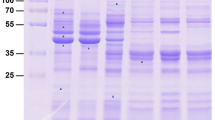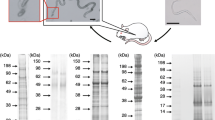Abstract
The excretory/secretory proteome of Echinostoma caproni (Trematoda: Echinostomatidae) adults collected from experimentally infected mice was investigated using a proteomic approach. We performed a shot-gun liquid chromatography/tandem mass spectrometry for the separation and identification of tryptic peptides from the excretory/secretory products of E. caproni adult worms. Database search was performed using MASCOT search engine (Matrix-Science) and ProteinPilot software v2.0 (Applied Biosystems). A total of 39 parasite proteins were accurately identified. Strikingly, metabolic enzymes, and particularly glycolytic enzymes, constituted the largest protein family in the excretory/secretory proteome of E. caproni adult worms. Moreover, representative proteins involved in parasite structure, response against stress, chaperones, calcium-binding, and signal transduction were also identified. This work extends our knowledge of host–parasite relationships in the E. caproni-rodent model that is extensively used to analyze the factors determining the intestinal helminth rejection. Consequently, information on many proteins may be useful to better understand the molecular basis that determines the survival of this parasite in the definitive host.
Similar content being viewed by others
References
Ahmed AK, Mun HS, Aosai F, Piao LX, Fang H, Norose K, Yano A (2004) Roles of Toxoplasma gondii-derived heat shock protein70 in host defense against T. gondii infection. Microbiol Immunol 48:911–915
Andrade MA, Siles-Lucas M, Espinoza E, Perez Arellano JL, Gottstein B, Muro A (2004) Echinococcus multilocularis laminated-layer components and the E14t 14-3-3 recombinant protein decrease NO production by activated rat macrophages in vitro. Nitric Oxide 10:150–155
Andresen K, Simonsen PE, Andersen BJ, Birch-Andersen A (1989) Echinostoma caproni in mice: shedding of antigens from the surface of an intestinal trematode. Int J Parasitol 19:111–118
Asea A (2008) Heat shock proteins and toll-like receptors. Handb Exp Pharmacol 183:111–127
Bergmann S, Rohde M, Chhatwal GSC, Hammerschmidt S (2001) alpha-Enolase of Streptococcus pneumoniae is a plasmin(ogen)-binding protein displayed on the bacterial cell surface. Mol Microbiol 40:1273–1287
Bernal D, De la Rubia JE, Carrasco-Abad AM, Toledo R, Mas-Coma S, Marcilla A (2004) Identification of enolase as a plasminogen-binding protein in excretory-secretory products of Fasciola hepatica. FEBS Lett 563:203–206
Bernal D, Carpena I, Espert AM, De la Rubia JE, Esteban JG, Toledo R, Marcilla A (2006) Identification of proteins in excretory/secretory extracts of Echinostoma friedi (Trematoda) from chronic and acute infections. Proteomics 6:2835–2843
Biagini GA, Park JH, Lloyd D, Edwards MR (2001) The antioxidant potential of pyruvate in the amitochondriate diplomonads Giardia intestinalis and Hexamita inflata. Microbiology 147:3359–3365
Chaithirayanon K, Grams R, Vichasri-Grams S, Hofmann A, Korge G, Viyanant V, Upatham ES, Sobhon P (2006) Molecular and immunological characterization of encoding gene and 14-3-3 protein 1 in Fasciola gigantica. Parasitology 133:763–765
Clapham DE (2007) Calcium signaling. Cell 131:1047–1058
Dougherty MK, Morrison DK (2004) Unlocking the code of 14-3-3. J Cell Sci 117:1875–1884
Guillou F, Roger E, Mone Y, Rognon A, Grunau C, Theron A, Mitta G, Coustau C, Gourbal BE (2007) Excretory-secretory proteome of larval Schistosoma mansoni and Echinostoma caproni, two parasites of Biomphalaria glabrata. Mol Biochem Parasitol 155:45–56
Higón M, Monteagudo C, Fried B, Esteban JG, Toledo R, Marcilla A (2008) Molecular cloning and characterization of Echinostoma caproni heat shock protein-70 and differential expression in the parasite derived from low- and high-compatible hosts. Parasitology 135:1469–1477
Jolodar A, Fischer P, Bergmann S, Büttner DW, Hammerschdmidt S, Brattig NW (2003) Molecular cloning of an alpha-enolase from the human filarial parasite Onchocerca volvulus that binds human plasminogen. Biochim Biophys Acta 1627:111–120
Khayath N, Mithieux G, Zitoun C, Coustau C, Vicogne J, Tielens AG, Dissous C (2006) Glyceroneogenesis: an unexpected metabolic pathway for glutamine in Schistosoma mansoni sporocysts. Mol Biochem Parasitol 147:145–153
Liu F, Cui SJ, Hu W, Feng Z, Wang ZQ, Han ZG (2009) Excretory/secretory proteome of the adult developmental stage of human blood fluke, Schistosoma japonicum. Mol Cell Proteomics 8:1236–1251
Mallet RT, Sun J, Knott EM, Sharma AB, Olivencia-Yurvati AH (2005) Metabolic cardioprotection by pyruvate: recent progress. Exp Biol Med 230:435–443
Marcilla A, Perez-Garcia A, Espert A, Bernal D, Muñoz-Antoli C, Esteban JG, Toledo R (2007) Echinostoma caproni: identification of enolase in excretory/secretory products, molecular cloning, and functional expression. Exp Parasitol 117:57–64
Marcilla A, De la Rubia JE, Sotillo J, Bernal D, Carmona C, Villavicencio Z, Acosta D, Tort J, Bornay FJ, Esteban JG, Toledo R (2008) Leucine aminopeptidase is an immunodominant antigen of Fasciola hepatica excretory and secretory products in human infections. Clin Vaccine Immunol 15:95–100
Muñoz-Antoli C, Sotillo J, Monteagudo C, Fried B, Marcilla A, Toledo R (2007) Development and pathology of Echinostoma caproni in experimentally infected mice. J Parasitol 93:854–859
Nakada T, Nagano I, Wu Z, Takahashi Y (2005) Molecular cloning and functional expression of enolase from Trichinella spiralis. Parasitol Res 96:354–360
Nowak TS, Loker ES (2005) Echinostoma paraensei: differential gene transcription in the sporocyst stage. Exp Parasitol 109:94–105
Olivencia-Yurvati AH, Blair JL, Baig M, Mallet RT (2003) Pyruvate-enhanced cardioprotection during surgery with cardiopulmonary bypass. J Cardiothorac Vasc Anesth 17:715–720
Perez-Sanchez R, Valero ML, Ramajo-Hernandez A, Siles-Lucas M, Ramajo-Martin V, Oleaga A (2008) A proteomic approach to the identification of tegumental proteins of male and female Schistosoma bovis worms. Mol Biochem Parasitol 161:112–123
Petri WAJ (2003) Can a proteomics strategy be used to identify the anti-malarial activity of chloroquine? Trends Pharmacol Sci 24:210–212
Pockley AG, Muthana M, Calderwood SK (2008) The dual immunoregulatory roles of stress proteins. Trends Biochem Sci 33:71–79
Ramajo-Hernández A, Oleaga A, Ramajo-Martín V, Pérez-Sánchez R (2007) Carbohydrate profiling and protein identification of tegumental and excreted/secreted glycoproteins of adult Schistosoma bovis worms. Vet Parasitol 144:45–60
Rzepecka J, Rausch S, Klotz C, Schnoller C, Kornprobst T, Hagen J, Ignatius R, Lucius R, Hartmann S (2009) Calreticulin from the intestinal nematode Heligmosomoides polygyrus is a Th2-skewing protein and interacts with murine scavenger receptor-A. Mol Immunol 46:1109–1119
Salazar-Calderón M, Martín-Alonso JM, Castro AM, Parra F (2003) Cloning, heterologous expression in Escherichia coli and characterization of a protein disulfide isomerase from Fasciola hepatica. Mol Biochem Parasitol 126:15–23
Seweryn E, Pietkiewicz J, Szamborska A, Gamian A (2007) Enolase on the surface of prockaryotic and eukaryotic cells is a receptor for human plasminogen. Postepy Hig Med Dosw (Online) 61:672–682
Shevchenko A, Jensen ON, Podtelejnikov AV, Sagliocco F, Wilm M, Vorm O, Mortensen P, Boucherie H, Mann M (1996) Linking genome and proteome by mass spectrometry: large-scale identification of yeast proteins from two dimensional gels. Proc Natl Acad Sci U S A 93:14440–14445
Shilov IV, Seymour SL, Patel AA, Loboda A, Tang WH, Keating SP, Hunter CL, Nuwaysir LM, Schaeffer DA (2007) The Paragon Algorythm, a next generation search engine that uses sequence temperature values and feature probabilities to identify peptides from tandem mass spectra. Mol Cell Proteomics 6:1638–1655
Siles-Lucas M, Gottstein B (2003) The 14-3-3 protein: a key molecule in parasites as in other organisms. Trends Parasitol 19:575–581
Smith RE, Spithill TW, Pike RN, Meeusen ENT, Piedrafita D (2008) Fasciola hepatica and Fasciola gigantica: cloning and characterization of 70 kDa heat-shock proteins reveals variation in HSP70 gene expression between parasite species recovered from sheep. Exp Parasitol 118:536–542
Sotillo J, Valero L, Sanchez Del Pino MM, Fried B, Esteban JG, Marcilla A, Toledo R (2008) Identification of antigenic proteins from Echinostoma caproni (Trematoda) recognized by mouse immunoglobulins M, A and G using an immunoproteomic approach. Parasite Immunol 30:271–279
Sotillo J, Trudgett A, Halferty L, Marcilla A, Esteban JG, Toledo R (2010) Echinostoma caproni: differential tegumental responses to growth in compatible and less compatible hosts. Exp Parasitol 125:304–309
Tew KD, Ronai Z (1999) GST function in drug and stress response. Drug Resist Updat 2:143–147
Toledo R, Fried B (2005) Echinostomes as experimental models for interactions between adult parasites and vertebrate hosts. Trends Parasitol 21:251–254
Toledo R, Espert A, Carpena I, Muñoz-Antoli C, Esteban JG (2003) An experimental study of the reproductive success of Echinostoma friedi (Trematoda: Echinostomatidae) in the golden hamster. Parasitology 126:433–441
Toledo R, Espert A, Muñoz-Antoli C, Fried B, Esteban JG (2004) Immunological characterization of somatic and excretory/secretory antigens of Echinostoma caproni (Trematoda: Echinostomatidae) in experimentally infected rats. Comp Parasitol 71:42–48
Toledo R, Espert A, Muñoz-Antoli C, Marcilla A, Fried B, Esteban JG (2005) Kinetics of antibodies and antigens in serum of mice experimentally infected with Echinostoma caproni (Trematoda: Echinostomatidae). J Parasitol 91:978–980
Toledo R, Esteban JG, Fried B (2006a) Immunology and pathology of intestinal trematodes in their definitive hosts. Adv Parasitol 63:289–370
Toledo R, Monteagudo C, Espert A, Fried B, Esteban JG, Marcilla A (2006b) Echinostoma caproni: intestinal pathology in the golden hamster, a highly compatible host, and the Wistar rat, a less compatible host. Exp Parasitol 112:164–171
Toledo R, Esteban JG, Fried B (2009) Recent advances in the biology of echinostomes. Adv Parasitol 69:147–204
Torres-Rivera A, Landa A (2008) Cooperative kinetics of the recombinant glutathione transferase of Taenia solium and characterization of the enzyme. Arch Biochem Biophys 477:372–378
Acknowledgements
This work was supported by the projects CGL2005-0231/BOS from the Ministerio de Ciencia e Innovación and FEDER (European Union), PROMETEO/2009/081 from Conselleria d'Educació, Generalitat Valenciana (Valencia, Spain), PS09/02355 from the Fondo de Investigación Sanitaria (FIS) del Ministerio de Ciencia e Innovación (Madrid, Spain) and FEDER, and UV-AE-10-23739 from the Universitat de València (Valencia, Spain). This work has been carried out while the first author (J.S.) was recipient of a pre-doctoral fellowship from the Ministerio de Ciencia e Innovación (Madrid, Spain). This research complies with the current laws for animal health research in Spain.
Author information
Authors and Affiliations
Corresponding author
Rights and permissions
About this article
Cite this article
Sotillo, J., Valero, M.L., Sánchez Del Pino, M.M. et al. Excretory/secretory proteome of the adult stage of Echinostoma caproni . Parasitol Res 107, 691–697 (2010). https://doi.org/10.1007/s00436-010-1923-x
Received:
Accepted:
Published:
Issue Date:
DOI: https://doi.org/10.1007/s00436-010-1923-x




